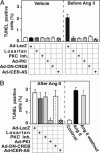A positive feedback loop of phosphodiesterase 3 (PDE3) and inducible cAMP early repressor (ICER) leads to cardiomyocyte apoptosis
- PMID: 16186489
- PMCID: PMC1253575
- DOI: 10.1073/pnas.0506489102
A positive feedback loop of phosphodiesterase 3 (PDE3) and inducible cAMP early repressor (ICER) leads to cardiomyocyte apoptosis
Abstract
cAMP plays crucial roles in cardiac remodeling and the progression of heart failure. Recently, we found that expression of cAMP hydrolyzing phosphodiesterase 3A (PDE3A) was significantly reduced in human failing hearts, accompanied by up-regulation of inducible cAMP early repressor (ICER) expression. Angiotensin II (Ang II) and the beta-adrenergic receptor agonist isoproterenol (ISO) also induced persistent PDE3A down-regulation and concomitant ICER up-regulation in vitro, which is important in Ang II- and ISO-induced cardiomyocyte apoptosis. We hypothesized that interactions between PDE3A and ICER may constitute an autoregulatory positive feedback loop (PDE3A-ICER feedback loop), and this loop would cause persistent PDE3A down-regulation and ICER up-regulation. Here, we demonstrate that ICER induction repressed PDE3A gene transcription. PDE3A down-regulation activated cAMP/PKA signaling, leading to ICER up-regulation via PKA-dependent stabilization of ICER. With respect to Ang II, the initiation of the PDE3A-ICER feedback loop depends on activation of Ang II type 1 receptor (AT1R), classical PKC(s), and CREB (cAMP response element binding protein). We further show that the PDE3A-ICER feedback loop is essential for Ang II-induced cardiomyocyte apoptosis. ISO and PDE3 inhibitors also induced the PDE3A-ICER feedback loop and subsequent cardiomyocyte apoptosis, highlighting the importance of this PDE3A-ICER feedback loop and cAMP signaling in cardiomyocyte apoptosis. Our findings may provide a therapeutic paradigm to prevent cardiomyocyte apoptosis and the progression of heart failure by inhibiting the PDE3A-ICER feedback loop.
Figures








Comment in
-
A positive feedback loop contributes to the deleterious effects of angiotensin.Proc Natl Acad Sci U S A. 2005 Oct 11;102(41):14483-4. doi: 10.1073/pnas.0507070102. Epub 2005 Oct 3. Proc Natl Acad Sci U S A. 2005. PMID: 16203975 Free PMC article. No abstract available.
Similar articles
-
Activation of extracellular signal-regulated kinase 5 reduces cardiac apoptosis and dysfunction via inhibition of a phosphodiesterase 3A/inducible cAMP early repressor feedback loop.Circ Res. 2007 Mar 2;100(4):510-9. doi: 10.1161/01.RES.0000259045.49371.9c. Epub 2007 Feb 1. Circ Res. 2007. PMID: 17272811 Free PMC article.
-
Functional role of phosphodiesterase 3 in cardiomyocyte apoptosis: implication in heart failure.Circulation. 2005 May 17;111(19):2469-2476. doi: 10.1161/01.CIR.0000165128.39715.87. Epub 2005 May 2. Circulation. 2005. PMID: 15867171 Free PMC article.
-
Regulation of phosphodiesterase 3 and inducible cAMP early repressor in the heart.Circ Res. 2007 Mar 2;100(4):489-501. doi: 10.1161/01.RES.0000258451.44949.d7. Circ Res. 2007. PMID: 17332439 Free PMC article. Review.
-
Inducible cAMP early repressor (ICER) is a negative-feedback regulator of cardiac hypertrophy and an important mediator of cardiac myocyte apoptosis in response to beta-adrenergic receptor stimulation.Circ Res. 2003 Jul 11;93(1):12-22. doi: 10.1161/01.RES.0000079794.57578.F1. Epub 2003 Jun 5. Circ Res. 2003. PMID: 12791704
-
Coupling signalling pathways to transcriptional control: nuclear factors responsive to cAMP.Recent Prog Horm Res. 1997;52:121-39; discussion 139-40. Recent Prog Horm Res. 1997. PMID: 9238850 Review.
Cited by
-
Selective regulation of cyclic nucleotide phosphodiesterase PDE3A isoforms.Proc Natl Acad Sci U S A. 2013 Dec 3;110(49):19778-83. doi: 10.1073/pnas.1305427110. Epub 2013 Nov 18. Proc Natl Acad Sci U S A. 2013. PMID: 24248367 Free PMC article.
-
Roles of A-Kinase Anchoring Proteins and Phosphodiesterases in the Cardiovascular System.J Cardiovasc Dev Dis. 2018 Feb 20;5(1):14. doi: 10.3390/jcdd5010014. J Cardiovasc Dev Dis. 2018. PMID: 29461511 Free PMC article. Review.
-
LOX-1 and angiotensin receptors, and their interplay.Cardiovasc Drugs Ther. 2011 Oct;25(5):401-17. doi: 10.1007/s10557-011-6331-7. Cardiovasc Drugs Ther. 2011. PMID: 21861069 Free PMC article. Review.
-
Therapeutic potential of PDE modulation in treating heart disease.Future Med Chem. 2013 Sep;5(14):1607-20. doi: 10.4155/fmc.13.127. Future Med Chem. 2013. PMID: 24047267 Free PMC article. Review.
-
PDE2A Is Indispensable for Mouse Liver Development and Hematopoiesis.Int J Mol Sci. 2020 Apr 21;21(8):2902. doi: 10.3390/ijms21082902. Int J Mol Sci. 2020. PMID: 32326334 Free PMC article.
References
-
- Kang, P. M. & Izumo, S. (2000) Circ. Res. 86, 1107-1113. - PubMed
-
- Olivetti, G., Abbi, R., Quaini, F., Kajstura, J., Cheng, W., Nitahara, J. A., Quaini, E., Di Loreto, C., Beltrami, C. A., Krajewski, S., Reed, J. C. & Anversa, P. (1997) N. Engl. J. Med. 336, 1131-1141. - PubMed
-
- Lohse, M. J., Engelhardt, S. & Eschenhagen, T. (2003) Circ. Res. 93, 896-906. - PubMed
-
- Iwai-Kanai, E., Hasegawa, K., Araki, M., Kakita, T., Morimoto, T. & Sasayama, S. (1999) Circulation 100, 305-311. - PubMed
Publication types
MeSH terms
Substances
Grants and funding
LinkOut - more resources
Full Text Sources
Other Literature Sources
Miscellaneous

